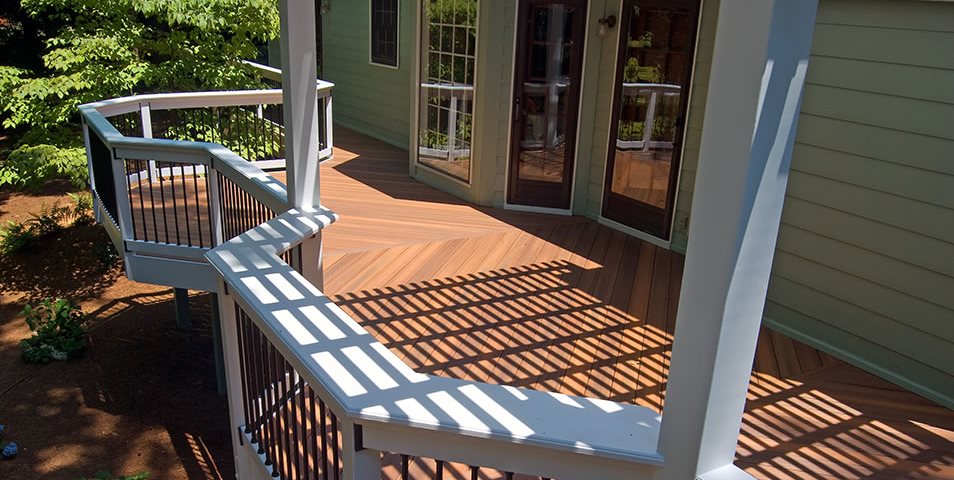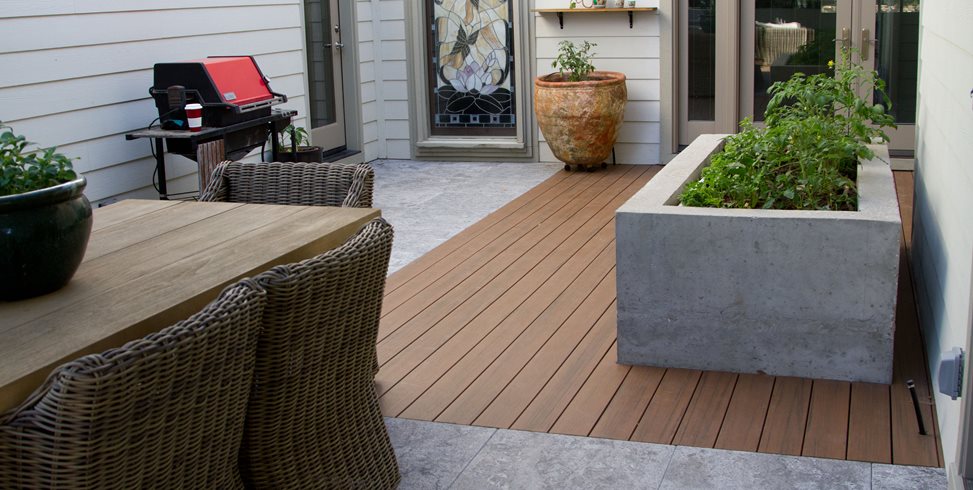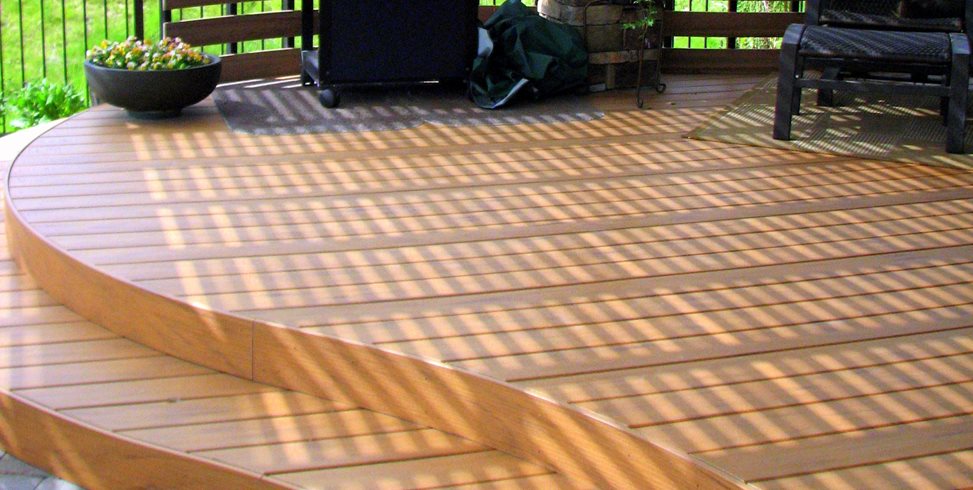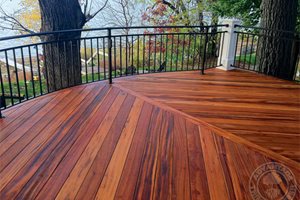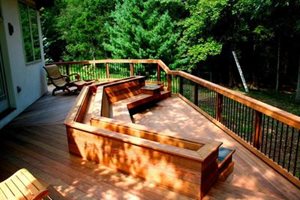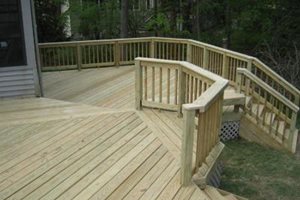Composite Decks
Learn the pros and cons of using composite decking as opposed to other materialsWhy Choose Composite Decking?
- Easy installation
- Low-maintenance
- Long-lasting
- Pet-friendly
- Scratch resistant
- Slip-resistant
- Design flexibility
- Made from recycled materials
- Hardware is invisible
Capped composite decking is one of the most popular choices among decking professionals. The deck boards are made of a PVC or plastic cap surrounding a core of ground wood and plastic, and come in a range of styles and colors. Here, contractors share their insights about using composite decking and provide insights on how composite decks measure up versus wood decks.
Pros and Cons of Composite Decking
Pros:
- Easy to install - Capped composite decking is easy to build with because the manufacturers sell all of the materials necessary for a seamless installation. Hidden fasteners, matching railings, and even deck lighting go with your choice of decking seamlessly for a clean, professional look.
- Low-maintenance - “99% of my clients ask for a low-maintenance landscape,” says Chuck Edwards of Breckon Land Design Inc. in Garden City, ID. Capped composite needs little care beyond hosing down the deck as needed or doing occasional spot cleaning with soap and water.
- Long-lasting - Most brands of composite decking are warrantied against warping, fading and other concerns for 25 years. While this warranty doesn’t cover labor costs, it does indicate the companies’ strong faith in their products.
- Pet-friendly and scratch resistant - “On one deck, my clients had two standard poodles,” says Edwards. “These were big, excitable dogs, and the deck looked just fine.” PVC-capped composites such as TimberTech’s XLM line tend to be the most scratch-resistant.
- ADA-certified for slip resistance - Most types of composite decking are certified as slip-resistant, in contrast to wood. “Wood can get slick when wet,” says Baron Biedenweg of Archadeck of Fort Wayne in Ft. Wayne, IN.
- Flexibility in design - Both composite decking and wood can be used for curves, diagonal slats, or to mirror the shape of bay or bow windows. There’s no difference in how you’d design with the materials.
- Made from recycled materials - Most brands of composite decking contain some quantity of recycled materials. For example, TimberTech uses 12% post consumer recycled plastics, as well as sawdust reclaimed from cabinetmakers and others in the woodworking industry. This is a plus for LEED projects.
- Hidden fasteners - Most brands of capped composite decking recommend that you use a hidden fastener system to minimize penetration of the caps. The advantage is that you don’t have to look at screw heads dotting the surface of your deck. Each brand has a hidden fastener system that works with their boards.
Cons:
- Harder to repair than wood - If you drop a hot coal from the barbecue or the business end of a hammer on your capped composite deck, the surface can melt or gouge. While small scratches and dings are simple to repair by using the tip of a household iron to melt the surface back into place, when a larger repair is needed you often have to replace the deck board. Capped composite boards are usually one-sided, so you can’t just flip the board if it gets damaged.
- Reflective in sunlight - Some styles of capped composite decking have a reflective shine in sunlight. For this reason, it’s a good idea to get samples of your favorite composites and ask your contractor if there are any finished decks you can look at before you make your decision.
- No way to recycle used boards - When the life of your deck is over, it’s likely your used composite deck boards will go to the landfill.
- Price - While a professionally-installed composite deck costs less than ipe, it’s not a low-budget option. If budget is a strong concern, pressure-treated wood will be your best bet.
Choosing the Design and Color
Each brand of composite decking has a number of different styles, and the best choice for you will depend on your personal tastes as well as your architecture. Contemporary homes look great with composite decking that has the look of oiled ipe, while traditional or Colonial homes may look best with PVC-capped decking that has a pale, even coloration. Here are three types of composite decking to look out for.
- Wood-look - “Capstock composites give the Brazilian hardwood look pretty much 100%,” says Bobby Parks of Peachtree Decks & Porches in Alpharetta, GA. Lines such as TimberTech’s Earthwood Evolutions have variegation and striping to get the look of real wood.
- PVC-capped - Many brands offer a cellular PVC cap which is slightly harder and more resistant to scratching. The coloration on PVC-capped composite is more even and has a slightly pastel color, with less color variation than composites that aim to look like Brazilian hardwoods.
- Traditional - Lower-end composite decking doesn’t have a smooth outer layer on it, so it’s more porous and gets stained or dirty more easily. The advantage to this older type of composite is that it has a brushed surface which makes it easy to sand out scuffs and scratches. The disadvantage is that the porous surface requires cleaning every one to two years with a specialized cleaner like Corte*Clean. Traditional non-capped composites are more budget-friendly than capped.
Each decking line has different characteristics as well as different colors and styles. If you are concerned about slip-resistance, consider a style that has deeper graining. However, if you have heavy foot traffic on your deck, deeper graining can make the deck harder to clean. Once you’ve had a chance to look at some of the different options in composite decking, talk with your contractor about budget, the style of your architecture, how you plan to use the deck, and your personal tastes. Your decking professional can help steer you towards the line of decking that will best suit all of those factors.

 Backyards
Backyards
 Front Yards
Front Yards

